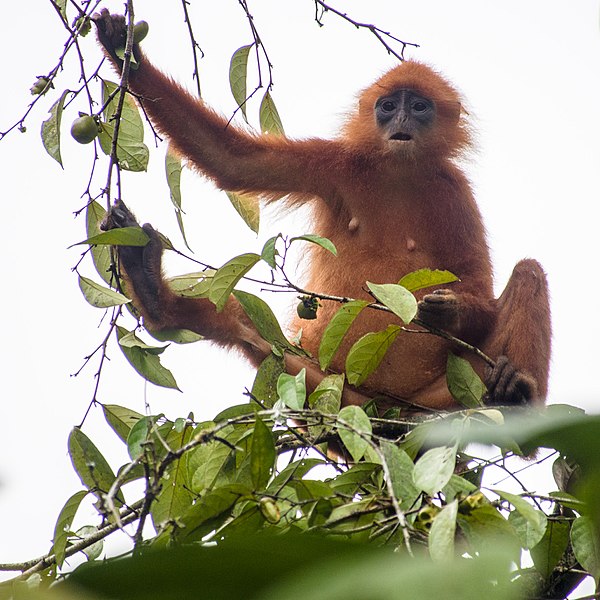Amazing Maroon Langur Facts For Kids 2024
The Maroon Langur, also known as the Maroon Leaf Monkey or Red Leaf Monkey, is a species of Old World monkey native to the rainforests of Southeast Asia. They are known for their distinctive maroon-colored fur and long tails, which they use for balance and communication. Maroon langurs are primarily arboreal and live in groups of up to 20 individuals, led by a dominant male. They primarily feed on leaves, fruits, and flowers and play an important role in dispersing seeds throughout their forest habitat. Despite being listed as Near Threatened by the International Union for Conservation of Nature (IUCN), maroon langurs continue to face habitat loss due to deforestation and fragmentation of their forest habitat.

Basic Maroon Langur Facts
Name :
The common name for this species is the Maroon Langur, but it is also known as the Maroon Leaf Monkey or Red Leaf Monkey. Its scientific name is Presbytis rubicunda.
Scientific Classification
The Maroon langur’s scientific classification is as follows:
- Kingdom: Animalia
- Phylum: Chordata
- Class: Mammalia
- Order: Primates
- Family: Cercopithecidae
- Genus: Presbytis
- Species: rubicunda
Latin Name
The Latin name of the Maroon Langur is Presbytis rubicunda.
Appearance (physical characteristics)
The Maroon Langur has a unique physical appearance, with maroon-colored fur most prominent on its back and legs. Its prehensile tail is used for balance and communication, and its slender build and long limbs allow for easy movement through trees. Its eyes are large and expressive, and a distinctive white patch around them resembles spectacles, making the Maroon Langur easily recognizable among other Old World monkeys.
Size and Weight
The Maroon Langur is a medium-sized monkey with a slender build, and adult males weigh between 5 to 7 kg and measure around 60 cm in body length. Females are slightly smaller, weighing between 3 to 5 kg and measuring around 50 cm. They have long limbs that are adapted for moving through trees and are important for seed dispersal in their ecosystem. Conserving these primates is essential for maintaining the biodiversity of Southeast Asian rainforests.

Habitat and Range
The Maroon Langur is native to the rainforests of Southeast Asia and can be found in primary and secondary forests, mangroves, and swamps up to an elevation of about 1,500 meters. They are primarily arboreal and live in groups led by a dominant male. They play a vital role in their ecosystem as seed dispersers but are threatened by habitat loss due to deforestation and fragmentation. Conservation efforts are necessary to protect their habitat and ensure their survival.
Diet
The Maroon Langur is a herbivorous primate that feeds on leaves, fruits, flowers, and seeds, with a preference for young leaves and specific plant species. Their digestive system is specialized to extract maximum nutrients from their diet. Their diet is crucial for seed dispersal, which supports the growth of new trees and the health of their forest ecosystem.
Life Expectancy
The Maroon Langur’s lifespan in the wild is estimated to be up to 20 years, while those in captivity can live up to 30 years. Their life expectancy can be affected by various factors such as habitat loss, hunting, and competition for resources. Female Maroon Langurs give birth to a single offspring after six months of gestation. Conservation efforts are necessary to protect them and ensure their long-term survival in the wild.
Fun facts about Maroon Langur
1. Red Leaf Monkey:

Also known as Presbytis rubicunda, the Maroon langur is commonly referred to as the red leaf monkey due to its maroon-colored fur coat that resembles the color of leaves in the forest.
2. Native to Southeast Asia:
Maroon langurs are found in Southeast Asia, specifically in Indonesia, Malaysia, and Thailand, in tropical and subtropical forests.
3. Arboreal Primates:
Maroon langurs are arboreal primates, spending most of their time high up in the trees, where they feed and rest.
4. Distinctive Maroon Coat:
The Maroon langur has a distinctive maroon-colored coat that makes them easy to spot in the forest canopy.
5. Herbivorous Diet:

Unlike many other primates, Maroon langurs are primarily herbivorous, feeding on leaves, fruit, and flowers that are available in the forests.
6. Group Living:
Maroon langurs live in groups of up to 20 individuals, which are led by a dominant male. Group dynamics play a crucial role in their social behavior and survival.
7. Acrobatic Abilities:
Maroon langurs are known for their acrobatic abilities, often leaping from tree to tree with ease. Their jumping skills and agility help them to move quickly through the canopy.
8. Vocal Communication:
Maroon langurs have a unique vocalization system, using various grunts and call to communicate with one another. They use different sounds to convey information about food sources, danger, and social interaction.
9. Endangered Status:
Maroon langurs are endangered due to habitat loss and hunting for their meat and fur. The destruction of their natural habitat and hunting practices have led to a decline in their population.
10. Sacred Animal:
In some regions, Maroon langurs are considered sacred and are protected by local communities. This cultural significance has helped to preserve their habitat and protect them from hunting and other threats.
11. Unique Reproductive System:
Maroon langurs have a unique reproductive system, where the females display sexual swelling during the mating season. This visual cue signals their reproductive status and attracts males for mating.
12. Color Vision:
Maroon langurs have excellent color vision, allowing them to distinguish between different shades of green, yellow, and red in the forest canopy. This ability helps them to locate and identify food sources efficiently.
13. Leafy Diets and Digestive System:
Maroon langurs have a unique digestive system that helps them to digest tough and fibrous leaves. They have a four-chambered stomach and a specialized gut microbiome that allows them to break down cellulose and extract nutrients from their leafy diet.
14. Cooperative Defense Strategy:
Maroon langurs employ a cooperative defense strategy against predators. When threatened, the group members will huddle together, making it difficult for the predator to single out an individual. They also use vocalizations and physical gestures to intimidate predators.
15. Role in Seed Dispersal:

Maroon langurs play an essential role in seed dispersal in their habitats. As they feed on fruit and leaves, they inadvertently consume and disperse seeds through their feces, contributing to the regeneration and maintenance of the forest ecosystem.
Conclusion
In conclusion, the Maroon Langur is an important species of Old World monkey that plays a vital role in the ecological health of Southeast Asian rainforests. Their unique maroon-colored fur and social behavior make them a fascinating subject of study, but their conservation status is cause for concern. With their forest habitats under threat from human activities such as deforestation and fragmentation, efforts must be made to protect and preserve these primates and their habitat. It is crucial that we recognize the importance of biodiversity and work towards a sustainable future that prioritizes the conservation of species like the Maroon Langur.
